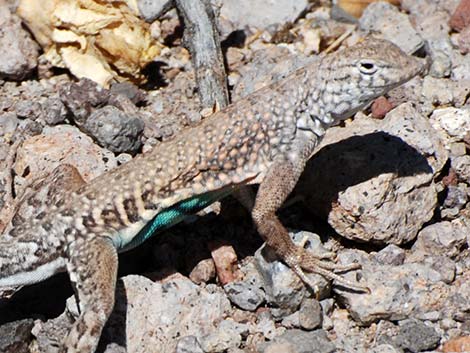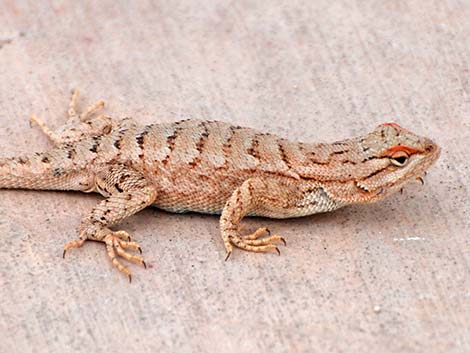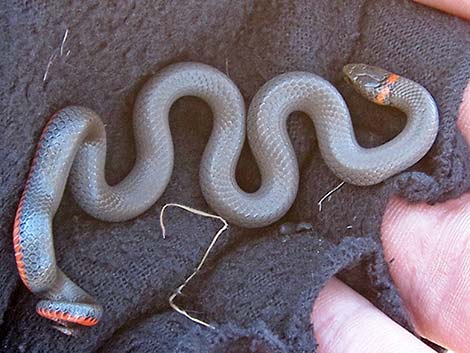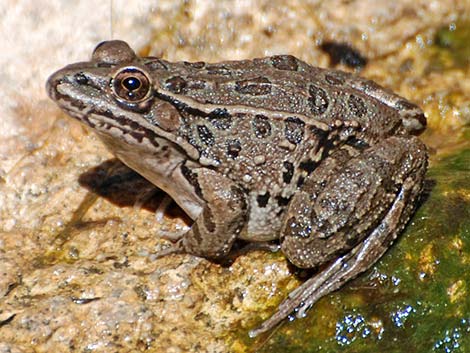
 Greater Earless Lizards (Cophosaurus texanus) |
The Zone-tail Ranch is a 320 acre (half of a section; one mile long and half a mile wide) piece of beautiful desert near the crest of the Aquarius Mountains, Arizona, at an elevation of about 5,000 feet. It is located east of Kingman (east of US-93) and south of I-40. The land is rocky canyon country with cliffs, seasonal streams, and perennial springs. Looking from the west, the Zone-tail Ranch is just above the level of the white cliffs where the land starts to flatten out. The ranch includes one major mountain top and one major canyon. Vegetation is dominated by Utah Juniper with some pinyon, oak, several varieties of cactus, yucca, and a diverse collection of shrubs and annual plants. |
 Plateau Fence Lizard (Sceloporus tristichus) |
The flora is transitional between the pinyon-juniper highlands and the Sonoran Desert lowlands and includes vegetation from both floristic zones. Perennial vegetation (including trees) covers about 20% of the ground. However, after a very wet winter, the annual grasses and flowers carpet the ground and the place looks much like a high alpine meadow. |
 Ringneck Snake (Diadophis punctatus) |
Reptiles, especially lizards, are abundant and diverse on the ranch, but the area seems to have been little studied by herpetologists. The distribution of species in this area is not well understood. Apparently, the ranges of higher elevation species are thought not to drop down as far as the ranch, and the ranges of lower elevation species are thought not to rise as high as the ranch. Because of this, we have made observations of several species that extend or clarify the edges of their ranges. For example, observations of greater and lesser earless lizards, black-necked garter snakes, ring-necked snakes, and lowland leopard frogs all extend or clarify range boundaries. |
 Western Blackneck Garter Snake (Thamnophis cyrtopsis cyrtopsis) |
While not unusual, I caught a spectacular 7.5 foot long gopher snake. I have caught a lot of gopher snakes, but never one as big and beautiful as this. One thing that was particularly neat was that when I first caught it, the snake made hissing sounds that sounded so much like the rattle of a rattlesnake that I immediately released it and stepped back to take another look. Convinced that my first identification was correct, I caught the snake again without being bit. Fortunately, I was building a cabin and had a tape measure, so I was able to measure the length of the snake. However, I was alone and the snake was too long to measure easily. So I measured the front half, released it, and then tried to measure the back half without getting bit. I didn't have much time to measure the back half, before the snake escaped through the wall of the cabin and into the scrub oak and prickly pear cactus under the pinyon tree. |
 Lowland Leopard Frog (Lithobates yavapaiensis) |
If interested, please see a list of the reptiles and amphibians that we have actually seen on the Zone-tailed Ranch, as well as species that might occur in the vicinity. If you have an interest in Arizona herps, send us a note. Other information on Arizona herps can be found at the Arizona Herpetological Association website. This group is dedicated to the conservation, education, and scientific study of reptiles and amphibians. The Tucson Herpetological Society is a similar group. They have links to other herp sites too. |
| ZT Ranch | Home |